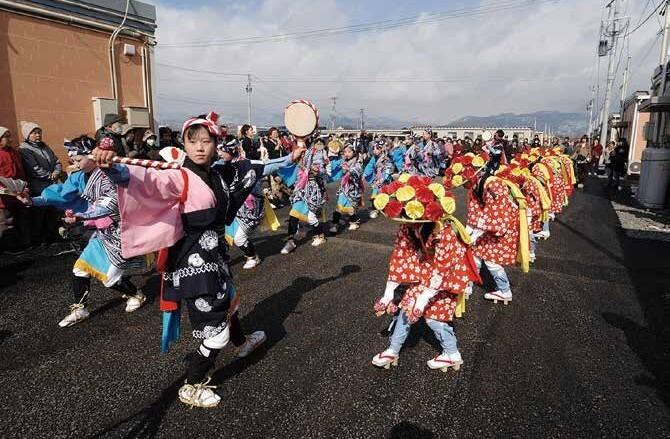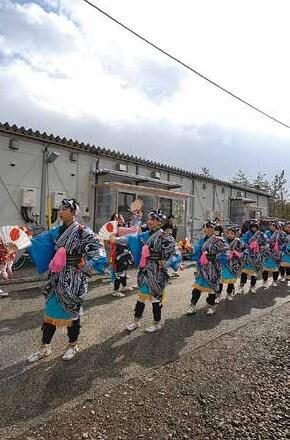Issue:

This is a short tribute to a lost village. I first saw it from a nearby hill on an autumn morning in 2011, almost nine months after the tsunami. It is called Ukedo, and it lies on a beach on Fukushima’s balmy shoreline. Lies is the operative word. At first, it was hard to tell that a 1,300 strong community had existed there, because its houses were broken stumps, and goldenrod flowers swept over the debris, blurring the boundary between village and surrounding marshland.
The place reminded me of Normandy in northwestern France. There were ducks and herons drifting lazily on the ponds, and salmon idling in the river. But jutting out of the undergrowth were vehicles and fishing boats that looked like the rusting shells of burnt out tanks left in the wake of the Normandy landings. On the horizon, the dark chimney stacks of the Fukushima Daiichi nuclear power plant loomed eerily through the mist. The only people I saw were wearing white hazmat suits to shield them from the radiation. As three of them chatted and sipped sake at a roadside shrine, they could have been ghosts of some of the 182 people in the area killed by the tsunami.
Ukedo haunts me. Perhaps it is its utter desolation. Perhaps it was being told that on the small hill where I stood, the tsunami had snagged those running for safety, pulling them away from the bamboo plants to which they desperately clung, drowning wives, sparing husbands. Perhaps it is the clutter of dislodged headstones in the graveyard, where the black waters of the tsunami have licked the burial urns clean, dissolving the bones and ashes into the surrounding swampy marshland. (This is the ultimate ignomy: not even the dead were spared). Perhaps it is the radiated burial site that it has become. Sitting so close to the nuclear power plant, it will probably never be rebuilt.
As I have tracked down its uprooted residents to reconstruct the lost village in my mind, I find in Ukedo a metaphor for a vanishing Japan. To Wakana Yokoyama, who was 12 when the tsunami killed her grandparents, village life is bound up with memories of them. She lived in one of the biggest houses; adjoining it was her grandfather’s workshop. He was the village’s shipwright. When she came home from school, she would sit on a swing that he had built for her in the garden and watch him work. She loved the way his hands wielded his tools. His work was recognized far and wide. In the Fukushima prefectural museum in Aizu Wakamatsu, I discovered one of his small wooden sailing boats preserved for posterity. Next to it was the wooden figure of a sea spirit meant to protect the boat. That was made by Wakana’s great grandmother. When I told Wakana I had seen them, her face beamed with pleasure.
The house was the closest in the village to the sea, so close, Wakana says, that her memory of it is bound up with the sound of the waves. Crabs would scuttle through her garden. Her favorite toys were the desiccated starfish thrown away by fishermen that she would toss across the beach like a frisbee. Fish and shellfish were always on the table. By the well in the garden, she would watch her grandfather gut the fish that he would often bring home after a brisk walk to the port, given to him for free by local fishermen. As far as Wakana can remember, her family never paid for a fish during her whole life in Ukedo. Her grandfather’s most mesmerizing trick was to use a fish knife with his left hand, open a salmon, and gently squeeze out the roe, which they ate on top of rice for breakfast. “He had hands like a god,” Wakana says. “Grandpa did it beautifully, better than anyone else on Earth.”
A different story of village life is told by Wakana’s 62 year old mentor, Shigeko Sasaki, who came to the village from her family home 10 miles away as a 19 year old bride, her father’s injunction ringing in her ears: “Never marry a poor man. Worse, never marry a poor man from Ukedo.” For her, living in Ukedo was a lifelong struggle for acceptance. Her husband built her a fine house, made from cedar chopped from her father’s farm. But then he disappeared. He would be gone for months on oceanic fishing trips without even warning her he was leaving. When he returned, the children would run upstairs and hide from the rough, bearded man they barely recognized. In his absence, drunken men would pass by the house at night, frightening her with their suggestive talk.

Eventually, her husband gave up the sea and devoted himself to carpentry. But as a drinker, he was as absent as ever. She called him a cuckoo. At night, he would head off to the bars of the nearby town. He would stagger home before dawn. Rarely did she receive much moral support from the villagers. Even when she took on responsibility for preserving one of the village’s most sacred traditions the folk dances performed by girls such as Wakana at the festival held every February she heard whispers of disapproval because she was not Ukedo born and bred.
It is those dances that are now Ukedo’s salvation. After the tsunami and nuclear accident, everyone in the village was evacuated. Wakana and her friends were scattered throughout Fukushima; Sasaki went to Tokyo. One day, walking through the high rise tower blocks of her temporary home near the Sumida River in Tokyo, the dance teacher received an unexpected phone call. A Shinto priest from Fukushima, who she had never met before, called about the dances. “Could we rescue them?” he asked. When she hesitated, he made an even stranger request. Could she sing one of the songs to him? Bashfully, she began to sing into her mobile phone a song called “Soma Nagareyama,” which dates back to samurai times. The more she sang, the more her spirits rose. It is a haunting song to hear, but the words are hopeful.
Soma Nagareyama, na-e na-e
Come over if you feel like it, na-e
In the middle of May
Chasing wild horses
Singing and dancing, na-e
Be cheerful, na-e
Come over, na-e
To Ukedo beach, na-e
Sea bream and plaice, na-e
Leaping up and down, na-e
UKEDO LIVES ON IN THEIR DANCES, EVEN AS MEMORY OF IT FADES AWAY, AND THE CHANCES OF RESCUING IT FROM THE RADIATION DRENCHED SOIL DIMINISH
With the help of the priest, Sasaki resolved to revive the dances. They re-created the uproarious dancing costumes red and yellow carnations on bamboo framed hats, black-and-white headscarves, multi colored robes, plastic swords, clogs and sandals that had been swept away in the tsunami. The priest hand carved the castanets that the children clicked in their fingers as they danced. Under Sasaki’s tutelage, the children gathered to rehearse from their evacuation shelters across Fukushima. They were delighted to see each other; each had been scattered to different schools, mourning their lost relatives and lifelong friendships that had been cruelly cut short.
Some of the elderly members of the village grumbled that it was too soon to dance when they were still mourning their lost ones and their ruined lives. But the children persevered. For 18 months now, they have performed the folk dances, lifting the spirits of those in evacuation shelters, as well as appearing on television and at the Tokyo International Forum in Yurakucho. The children, as young as five years old, dance with devoted concentration. When I saw them perform for three sweltering summer days at Meiji Jingu shrine in Shibuya last July, some of them ended up almost comatose from the fatigue and heat. But there were no tears.
Ukedo lives on in their dances, even as memory of it fades away, and the chances of rescuing it from the radiation drenched soil diminish. Curious to watch now is how the ocean that destroyed it laps gently at its desolate shoreline with a beguiling innocence, as if whispering, “Mischievous? Who, me?”
Many of the children have already forgiven it. It is life by the sea that they miss most. For 1,000 years, they recall, the ocean kept them safe and provided Ukedo with innumerable bounties. That, too, is reflected in the dances they preserve. The children still perform them every February as part of the village’s annual pageant. Its name, Amba Matsuri, says it all. In English, it is called the Festival of the Safe Wave.
Henry Tricks has been the Tokyo Bureau Chief of The Economist since 2009.

